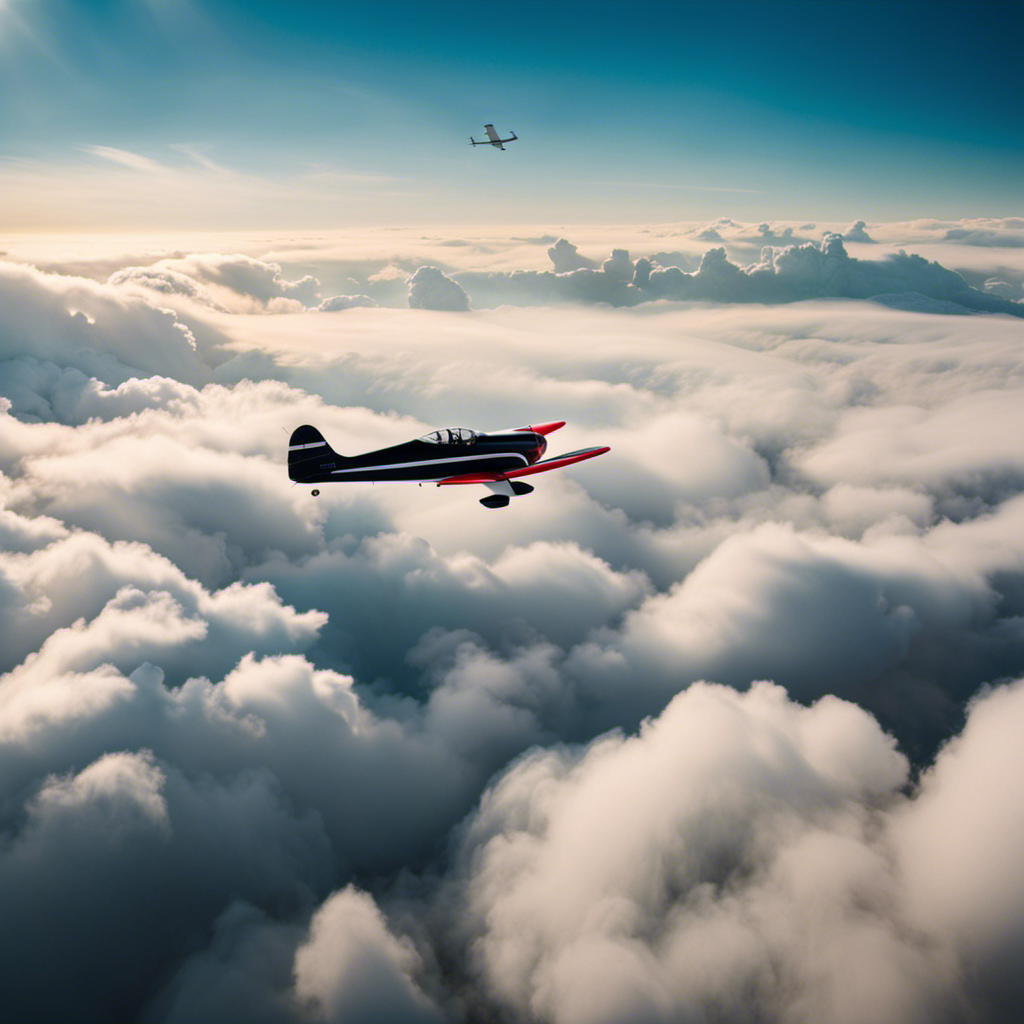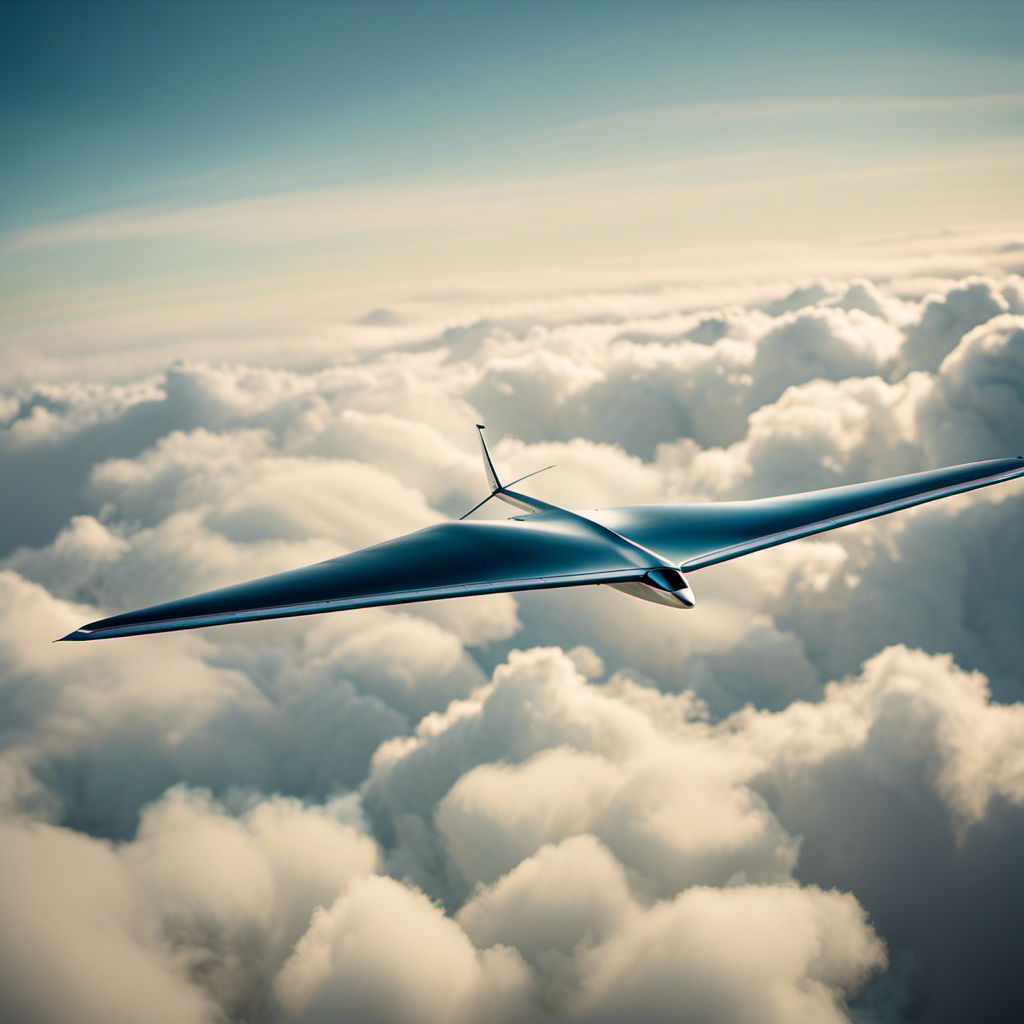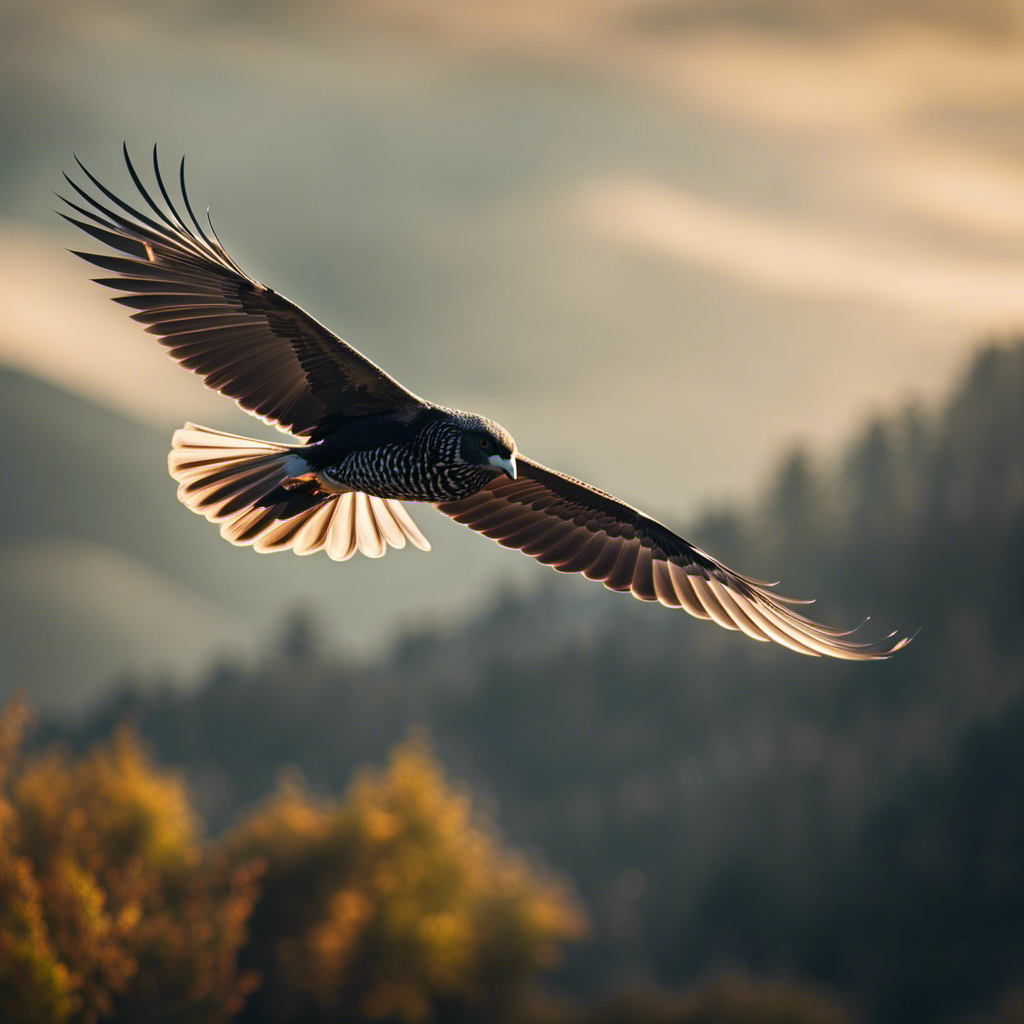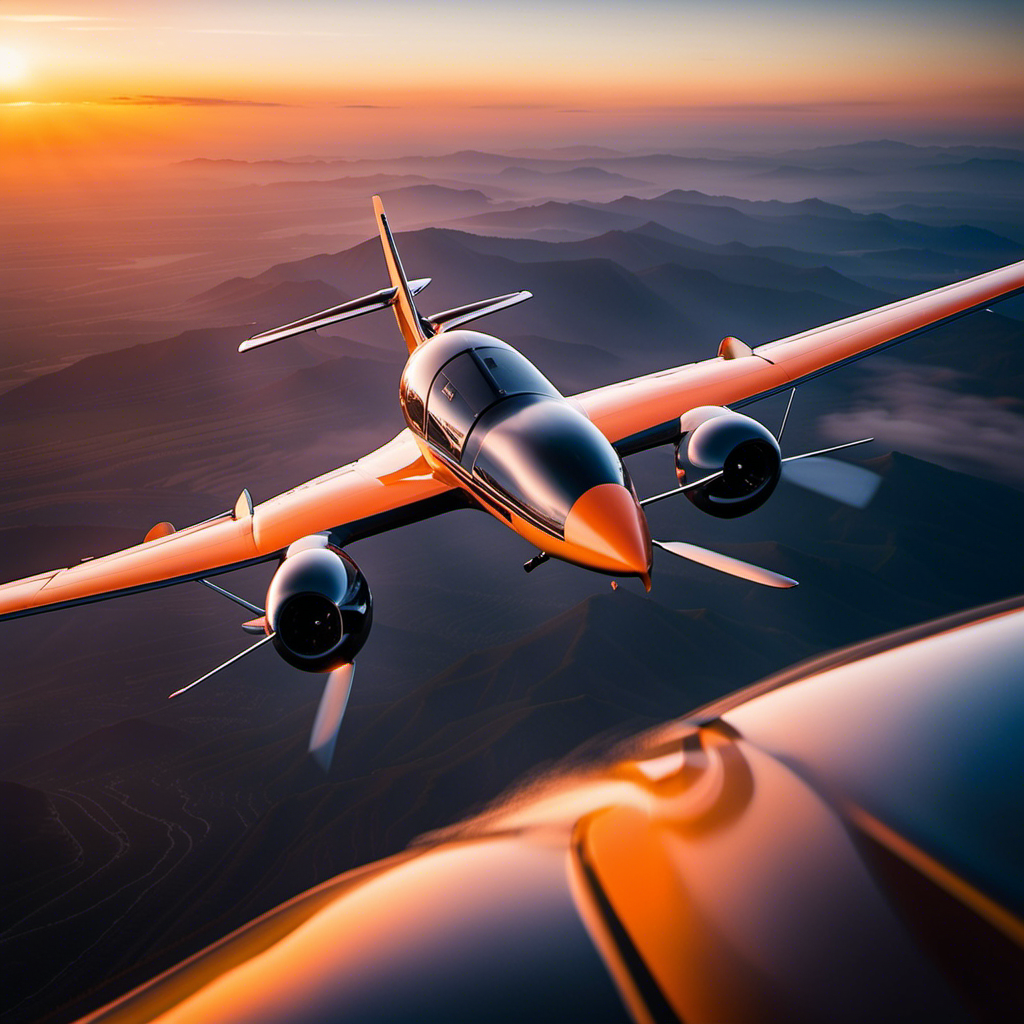Imagine yourself soaring through the sky, feeling the rush of the wind against your face and the thrill of being suspended in mid-air.
That’s exactly what gliderplanes offer, an exhilarating experience of flight without an engine. In this article, I will demystify the world of gliderplanes, exploring how they work, their history, different types, safety measures, and training.
Join me as we uncover the advantages, challenges, and incredible destinations that await those who are curious to explore the world of gliderplanes.
Key Takeaways
- Safety protocols and qualified instructors ensure the well-being of gliderplane pilots by reducing risks and providing proper training and guidance.
- Joining gliding clubs offers opportunities to network with fellow enthusiasts, learn from experienced pilots, and improve flying skills.
- Gliderplanes are cost-effective, as they do not require fuel or engines, resulting in reduced operating costs and zero emissions.
- Gliderplanes provide a versatile flying experience that allows pilots to stay aloft for extended periods, explore different flight techniques, and enjoy the freedom and serenity of engineless flight.
How Gliderplanes Work
To understand how gliderplanes work, you’ll need to grasp the concept of lift and how it keeps the aircraft in the air. Gliderplane aerodynamics is based on the principles of gliding flight, where the aircraft stays airborne without the use of an engine. Instead, gliderplanes rely on the forces of nature, such as gravity and air currents, to maintain their flight.
The key principle behind gliding flight is the creation of lift. Lift is generated when the airflow over the wings creates a pressure difference, with lower pressure on top and higher pressure on the bottom. This pressure difference creates an upward force that counteracts the force of gravity, allowing the gliderplane to stay aloft.
To maximize lift, gliderplanes are designed with long, narrow wings that are curved on top and relatively flat on the bottom. This shape, known as an airfoil, helps to create the necessary pressure difference for lift generation. Additionally, gliderplanes often have a high aspect ratio, which is the ratio of the wing’s length to its width. A higher aspect ratio increases the efficiency of the wings and improves the gliderplane’s glide ratio.
In the subsequent section, we will delve into a brief history of gliderplanes and explore how they have evolved over time to become the efficient and versatile aircraft we know today.
A Brief History of Gliderplanes
The Wright brothers were the first to successfully fly a glider in 1902. Since then, gliderplanes have come a long way and have become a popular sport worldwide. Gliderplanes are often used in competitions, where pilots showcase their skills and compete for distance, speed, and accuracy. These competitions push the boundaries of what gliderplanes can achieve and serve as a platform for innovation in the field.
Notable gliderplane pilots have emerged over the years, such as Paul MacCready, who won the first Kremer Prize for human-powered flight, and Hanna Reitsch, a pioneering female aviator who set numerous records in glider flying. These pilots have not only contributed to the development of gliderplanes but have also inspired others to take up the sport.
The thrill of flying without an engine is something that cannot be easily described. It is a feeling of freedom, of being one with the elements, and relying solely on your skills and the forces of nature to stay aloft. Gliding through the air, riding the thermals, and soaring with the birds is a truly exhilarating experience. It allows you to see the world from a different perspective, to appreciate the beauty of the landscape below, and to feel a sense of awe and wonder.
The absence of an engine also adds a level of challenge and excitement to the sport, as pilots must constantly read the air currents, make strategic decisions, and use their expertise to stay airborne. Flying a gliderplane is not just a recreational activity; it is a passion, a lifestyle, and a lifelong pursuit of adventure in the skies.
The Thrill of Flying Without an Engine
Flying a gliderplane without an engine is an exhilarating experience that allows me to feel a sense of freedom and connect with the elements. As I soar through the sky, there is a certain joy in knowing that I am completely dependent on nature’s forces to keep me aloft. Here are some aspects of this unique flying experience that always leave me in awe:
-
The silence: Without the constant noise of an engine, the only sounds I hear are the wind rushing past and the occasional calls of birds. This silence creates a serene and peaceful atmosphere that is hard to replicate in any other form of aviation.
-
The breathtaking views: Gliding offers a front-row seat to some of the most stunning landscapes. From majestic mountains to vast open plains, I am able to appreciate the beauty of nature from a whole new perspective.
-
The feeling of weightlessness: As the gliderplane catches thermals and rises effortlessly, I experience a sensation of weightlessness. It’s as if I am floating in the air, untethered from the constraints of gravity.
-
The connection to the elements: Gliding allows me to truly feel the wind, to harness its power and use it to my advantage. I become attuned to the subtle changes in air currents, constantly adjusting my flight path to stay aloft.
Flying a gliderplane without an engine is not just a thrilling adventure; it’s a way to connect with nature and experience the joy of soaring.
Now, let’s explore the different types of gliderplanes that make this incredible experience possible.
Types of Gliderplanes
Take a closer look at the various types of gliderplanes available to explore the exhilarating world of soaring. Gliderplane competitions have become increasingly popular over the years, showcasing the incredible skills and techniques of pilots. These competitions not only test the pilot’s abilities but also highlight the advancements in gliderplane design.
One type of gliderplane commonly seen in competitions is the Standard Class glider. These gliderplanes have a wingspan of around 15 meters and are designed for cross-country flying. They are known for their versatility and are often used by pilots who want to participate in both local and international competitions.
Another type of gliderplane is the Open Class glider. These gliderplanes have longer wingspans, ranging from 18 to 20 meters. They are built for speed and are often used in competitions where pilots strive to achieve maximum distance and speed.
In recent years, gliderplane design advancements have led to the development of high-performance gliders. These gliderplanes are equipped with features such as winglets, which reduce drag and improve overall performance. They are designed to maximize lift and glide ratio, allowing pilots to stay aloft for longer periods.
As we delve into the world of gliderplanes, it is crucial to understand the importance of safety measures and training. Without proper training and adherence to safety protocols, the thrill of gliderplane flying can quickly turn into a dangerous endeavor. Let’s explore the essential safety measures and training required to ensure a safe and enjoyable gliderplane experience.
Safety Measures and Training
To ensure a safe and enjoyable gliderplane experience, it’s important for you to prioritize safety measures and undergo proper training. Safety protocols play a crucial role in the world of gliderplanes. Before taking to the skies, it is essential to familiarize yourself with the safety procedures and guidelines. Gliderplane accidents are rare, but by following these protocols, you minimize the risk even further. From pre-flight inspections to emergency procedures, these measures are designed to keep you safe throughout your journey.
In addition to safety protocols, the qualifications of your instructor are equally important. When choosing an instructor, make sure they have the necessary certifications and experience. An instructor who is knowledgeable and experienced in gliderplanes can provide you with the proper training and guidance needed to become a skilled pilot. They will teach you the fundamental principles of flying, maneuvers, and emergency procedures, ensuring you are well-prepared for any situation that may arise during your gliderplane experience.
Gliding Clubs and Communities
Once you join a gliding club, you’ll have the opportunity to connect with fellow enthusiasts and expand your knowledge and skills in gliderplanes. Being a part of a gliding community offers numerous benefits that enhance your overall gliding experience. Here are some key advantages:
-
Networking: Gliding clubs bring together people who share a common passion for gliderplanes. You can meet experienced pilots, instructors, and even potential co-pilots for future flights. The exchange of knowledge and experiences is invaluable in improving your flying skills.
-
Competitions: Many gliding clubs organize gliding competitions, where you can test your skills against other pilots. These events provide a platform to showcase your abilities, learn from seasoned competitors, and push your limits to new heights.
-
Maintenance: Gliderplane maintenance is a crucial aspect of being a glider pilot. Gliding clubs often have dedicated workshops and facilities where you can learn and practice essential maintenance tasks. Understanding how to properly care for and maintain your gliderplane ensures its optimal performance and longevity.
Advantages of Gliderplanes
When you’re part of a gliding community, you’ll have the opportunity to learn from experienced pilots and improve your skills. Gliderplanes offer a range of benefits and features that make them a popular choice among aviation enthusiasts.
One of the main advantages of gliderplanes is their cost-effectiveness. Unlike powered aircraft, gliderplanes don’t require fuel or an engine, which significantly reduces operating costs. Additionally, gliderplanes are environmentally friendly as they produce zero emissions.
Another benefit of gliderplanes is their versatility. These aircraft are designed to stay aloft for extended periods using only atmospheric currents, allowing pilots to explore different flight techniques and enhance their understanding of meteorology.
Furthermore, gliderplanes offer a unique sense of freedom and serenity. The absence of engine noise and vibrations creates a peaceful environment, allowing pilots to fully immerse themselves in the beauty of the surrounding landscape.
However, it’s important to note that gliderplanes also come with their own set of challenges and risks, which will be discussed in the next section.
Challenges and Risks of Gliderplanes
After exploring the advantages of gliderplanes, it’s important to acknowledge the challenges and risks associated with this exhilarating activity. While gliding offers a unique and thrilling experience, it is not without its difficulties.
One of the main challenges of gliderplanes is their reliance on weather conditions. Since gliders do not have an engine, they must rely on natural air currents to stay aloft. This means that pilots must carefully monitor weather patterns and make informed decisions about when it is safe to fly. Additionally, unexpected changes in weather can pose a risk to gliderplanes, requiring pilots to be skilled in reading the atmosphere and making quick adjustments.
Another challenge of gliderplanes is their limited flight duration. Unlike powered aircraft, gliders have a finite amount of time they can stay in the air before they must return to the ground. This requires pilots to plan their flights meticulously and make the most of the time they have.
Despite these challenges, the rewards of glider flying are well worth the efforts. Now, let’s delve into the gliding destinations around the world, where pilots can experience the thrill of soaring through the skies.
Gliding Destinations around the World
Now let’s explore some of the top gliding destinations across the globe, where pilots can discover breathtaking views and unforgettable flying experiences.
One of the most renowned gliding destinations is in Omarama, New Zealand. With its stunning alpine landscapes, it offers ideal conditions for gliding techniques and provides pilots with a thrilling experience.
Another popular spot is in Interlaken, Switzerland, where pilots can glide over the snow-capped peaks of the Swiss Alps, providing a truly awe-inspiring sight.
The Great Plains in the United States also offer vast open spaces for soaring, with gliding competitions often held in places like Nebraska and Kansas.
In Austria, the Zell am See-Kaprun region is a favorite among glider pilots. Surrounded by the majestic Austrian Alps, this destination provides a combination of challenging gliding techniques and breathtaking views.
The Patagonian region in Argentina is another must-visit location for glider enthusiasts. Its diverse landscapes, from the Andes Mountains to the vast steppes, offer incredible flying opportunities.
With so many incredible gliding destinations around the world, pilots have the opportunity to explore different terrains, climates, and cultures while honing their gliding skills.
And now, let’s delve into the next section and discover how to get started with gliderplanes, where we will explore the basics of this exhilarating sport.
Getting Started with Gliderplanes
To begin with gliderplanes, you’ll need to familiarize yourself with the basic principles of flight. Gliderplanes are aircraft that do not have an engine and rely solely on the forces of lift and gravity to stay airborne. They are designed to glide through the air, using updrafts and thermals to gain altitude and stay aloft for extended periods of time.
When it comes to gliderplane maintenance, regular inspections and upkeep are crucial to ensure safe and efficient operation. This includes checking the airframe for any signs of wear or damage, inspecting the control surfaces and cables, and maintaining the canopy and landing gear. It’s also important to keep the gliderplane clean and free of debris, as even small particles can affect its performance.
In terms of gliderplane equipment, there are several essentials that every pilot should have. These include a parachute for emergency situations, a variometer to measure the rate of climb or descent, a radio for communication with air traffic control, and a GPS navigation system for accurate positioning and route planning. Additionally, a flight computer and a cockpit checklist are invaluable tools for calculating and monitoring various flight parameters.
Overall, getting started with gliderplanes requires a solid understanding of flight principles, regular maintenance, and the right equipment. By following these guidelines, you can embark on the thrilling journey of soaring through the skies in a gliderplane.
| Maintenance | Equipment |
|---|---|
| Regular inspections | Parachute |
| Airframe checks | Variometer |
| Control surface inspection | Radio |
| Canopy and landing gear | GPS navigation system |
| Cleaning and debris removal | Flight computer |
| Cockpit checklist |
Frequently Asked Questions
Can gliderplanes be converted to powered aircraft?
Yes, gliderplanes can be converted into powered aircraft through modifications. By adding an engine and fuel system, the gliderplane becomes capable of independent propulsion, allowing it to take off without the need for a tow or launching from a hill.
How long can a gliderplane stay in the air without a thermal lift?
Without thermal lift, gliderplane endurance depends on various factors such as altitude, wind speed, and pilot skill. By utilizing gliderplane flight techniques like ridge soaring and wave soaring, I can extend the duration of my flight.
Can gliderplanes be used for commercial purposes?
Yes, gliderplanes can be used for commercial purposes. They have various commercial applications, such as aerial photography, surveying, and advertising. The economic viability of using gliderplanes depends on factors like demand and operational costs.
Are there any age restrictions for flying gliderplanes?
There are age restrictions for flying gliderplanes. The minimum age varies by country, but most require pilots to be at least 14 or 16 years old. Safety considerations include physical and mental fitness requirements.
What are the regulations regarding gliderplane maintenance and inspections?
Gliderplane maintenance and inspections are regulated to ensure safety. Regular inspections are required to check for any potential issues or wear and tear. Maintenance tasks include servicing the engine, checking control surfaces, and inspecting the airframe for any damage.
Conclusion
In conclusion, exploring the world of gliderplanes has been a breathtaking journey. Experiencing the sheer freedom of flying without an engine is like dancing with the wind, gracefully soaring through the sky.
Gliderplanes have a rich history and offer a wide variety of types to suit every pilot’s preferences. While safety measures and training are crucial, the advantages of gliderplanes, such as eco-friendliness and cost-effectiveness, make it a truly remarkable adventure.
So, spread your wings and embark on this exhilarating gliding experience.
With a heart that soars as high as the skies, Aria, affectionately known as “Skylark,” is the driving force behind Soaring Skyways. Her journey into the gliding world began as a young dreamer gazing up at the soaring birds, yearning to experience the weightlessness and freedom they embodied. With years of experience both in the cockpit and behind the scenes, Aria’s commitment to the gliding community is unwavering.










